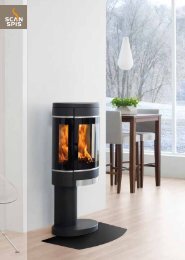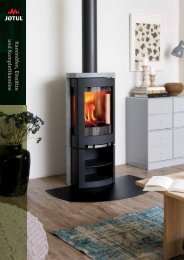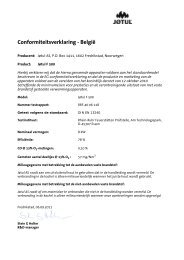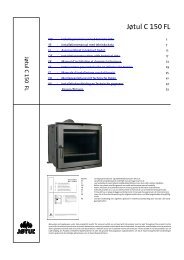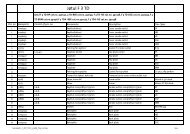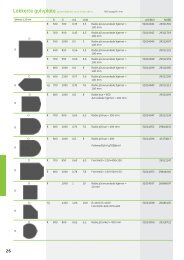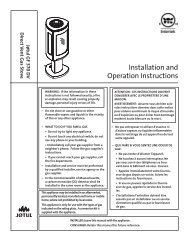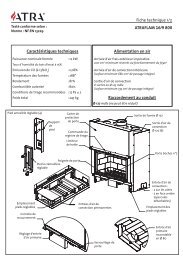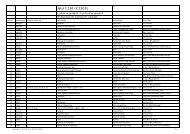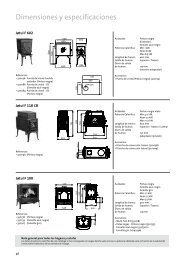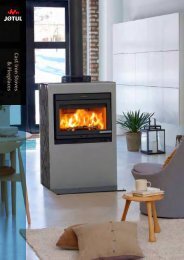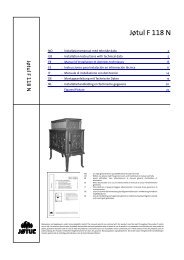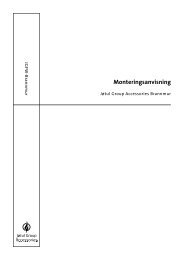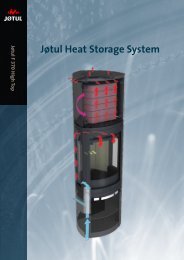Accessories for stoves and fireplace inserts - Jøtul stoves and ...
Accessories for stoves and fireplace inserts - Jøtul stoves and ...
Accessories for stoves and fireplace inserts - Jøtul stoves and ...
You also want an ePaper? Increase the reach of your titles
YUMPU automatically turns print PDFs into web optimized ePapers that Google loves.
Technical data<br />
3G <strong>fireplace</strong>s<br />
The third generation of <strong>stoves</strong> <strong>and</strong> <strong>fireplace</strong> <strong>inserts</strong> (3G) is<br />
the next step to attain more effective heat recovery. Up to<br />
now there has been a huge energy loss in open <strong>fireplace</strong>s<br />
with efficiency of 15-20%, plain ones with glass door <strong>and</strong><br />
uncontrolled air inflow (40-60%) <strong>and</strong> finally contemporary<br />
furnaces with advanced structures (more than 70%<br />
efficiency).<br />
2. 3.<br />
1.<br />
As opposed to older generations of products, 3G <strong>fireplace</strong>s<br />
<strong>and</strong> furnaces recover heat energy from exhaust gases. It is<br />
achieved through additional devices which are mounted<br />
between the hearth <strong>and</strong> a smoke duct. These are available<br />
convectors <strong>and</strong> radiators (1), water exchangers (2) <strong>and</strong> last<br />
but not least accumulating masses HSS (3). There<strong>for</strong>e, using<br />
3G heat receivers allows to obtain more energy (from 4 to 12<br />
kW) <strong>and</strong> to save up to 30% of fuel.<br />
It is recommended to combine 3G <strong>fireplace</strong>s with electronic<br />
flame controller ERS, which optimize the combustion<br />
process – from kindling through refueling to end up with fire<br />
extinction. Electronic flame controller ERS control the set<br />
temperature <strong>and</strong> steer the amount of air inflow required <strong>for</strong><br />
kindling <strong>and</strong> burning process.<br />
Chimney connection<br />
tmax 70 o C<br />
tmax 70 o C<br />
tmax 40 o C<br />
tmax 120 o C<br />
tmax 550 o C<br />
tmax 60 o C<br />
tmax 120 o C<br />
tmax 300 o C<br />
12<br />
13<br />
1<br />
7<br />
5<br />
14<br />
10 11<br />
9<br />
3 4<br />
8<br />
6<br />
400 o C<br />
(550 o C)<br />
2<br />
Fireplace insert (1) is connected to the smoke duct (2) by<br />
means of a set of transition pieces <strong>and</strong> steel pipes (3). In<br />
order to secure a safe <strong>and</strong> stable connection, one should<br />
use a chimney crossing (4) which permits flexible <strong>and</strong> tight<br />
connection of the pipes with the chimney.<br />
Fireplace insert is provided with fresh air needed <strong>for</strong><br />
combustion by a 100mm diameter pipe (5). By using a choke<br />
valve with flexible regulation (6) it is possible to dose the<br />
amount of air <strong>for</strong> a correct combustion process. Exhaust<br />
gases are carried off the insert’s combustion chamber (1) <strong>and</strong><br />
led to the smoke duct (2).<br />
Hot air distribution<br />
Operation of heating system is based on using convection<br />
heat. The air (7) warmed to room temperature flows under<br />
the <strong>fireplace</strong> insert (1) <strong>and</strong> is heated up in the space between<br />
<strong>fireplace</strong>’s body <strong>and</strong> its cover (8). Heated air flows up<br />
towards the top part of a distributor (9) <strong>and</strong> then divides.<br />
Next the heated air flows into the rooms through aluminum<br />
Spiro pipes (10), galvanized pipes (11) <strong>and</strong> ducts (12). The<br />
pipes’ <strong>and</strong> ducts’ outlets are furnished with wall grates<br />
with regulation, which dispense the appropriate amount<br />
of heated air into the rooms. However, there are also wall<br />
grates without regulation (13) <strong>and</strong> these are installed on the<br />
<strong>fireplace</strong>’s surrounding. In order to prevent the surrounding<br />
from cracking when it is adjacent to a wall, it is necessary to<br />
ventilate the space above the hot air distributor with the use<br />
of the grate (14).<br />
19



